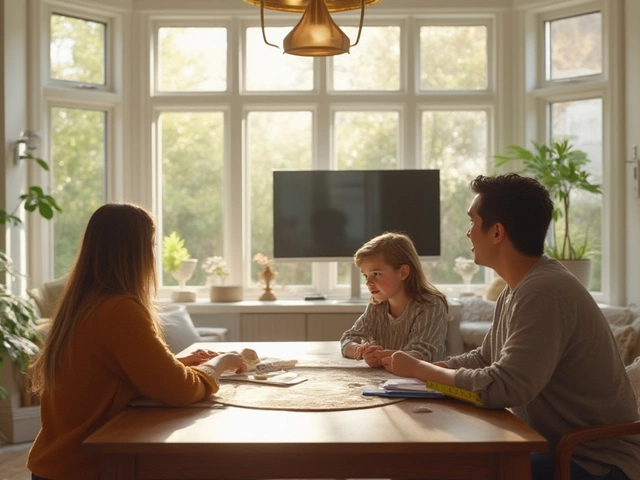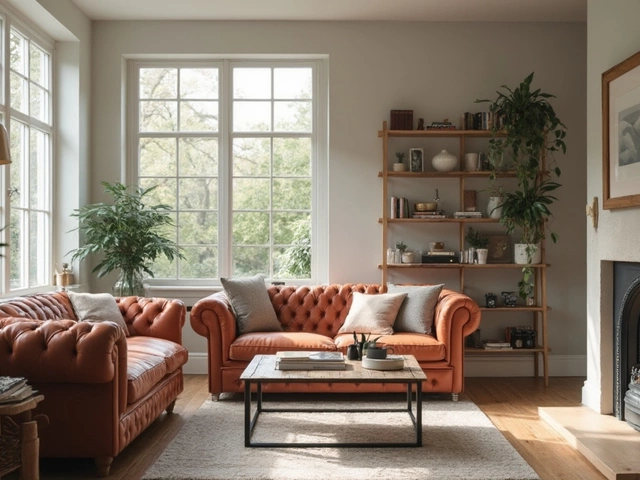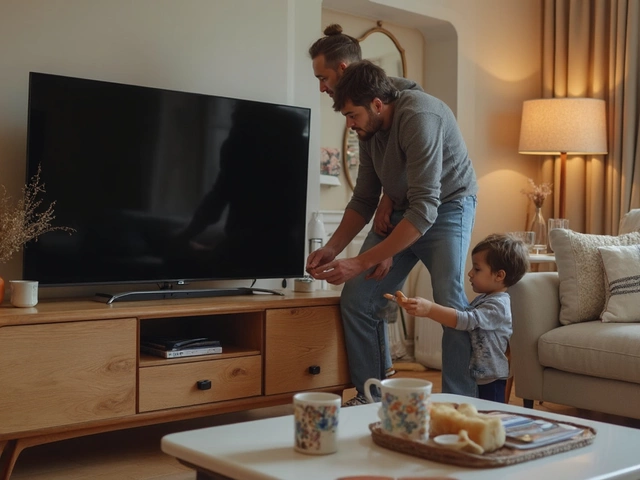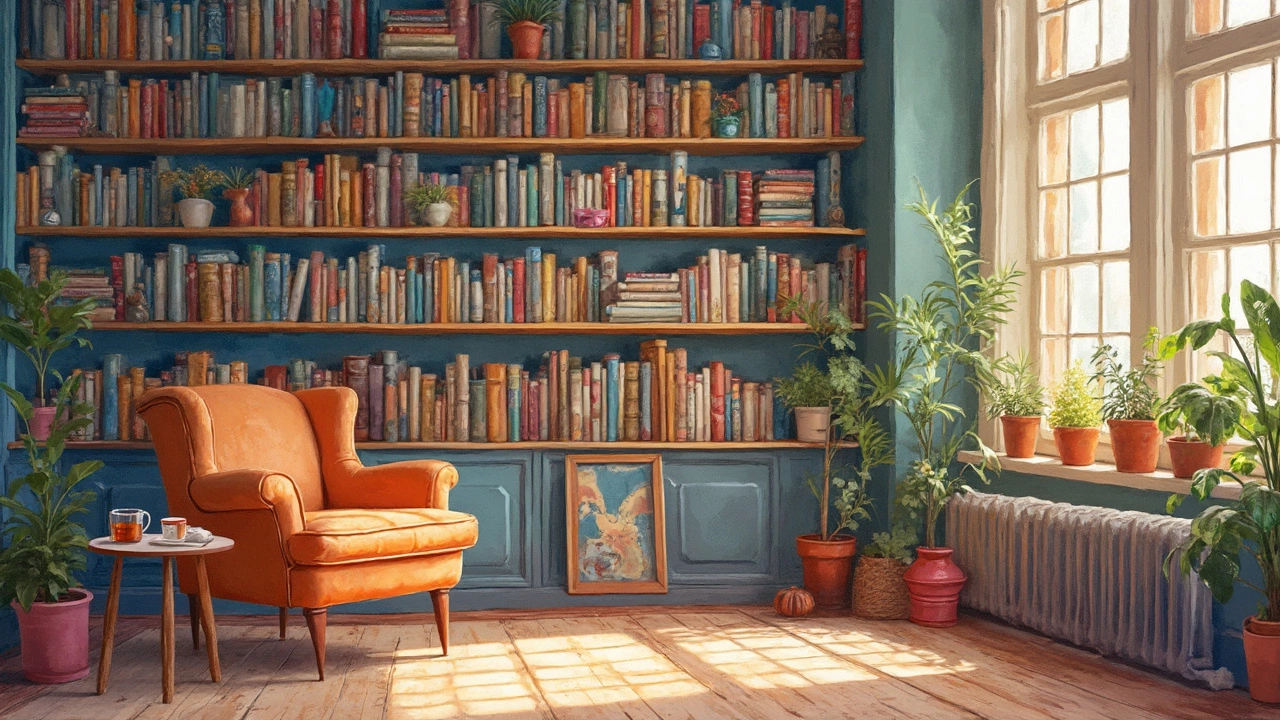 6
Jun,2025
6
Jun,2025
Ever walk into someone’s place and notice their bookshelf right away? It’s not just for show. Bookshelves in the living room pull real weight, giving you a spot for books, photos, plants, or even that weird souvenir you can’t throw out. Adding one isn’t about copying some glossy magazine setup—it’s about making the most out of the space you actually use every day.
If you’re juggling stacks of books on the coffee table, or tired of seeing chargers and board games tossed in a corner, a bookshelf gives everything a home. You’d be surprised how a simple upright shelf can calm down the chaos, even in tight apartments. Plus, picking the right shelf turns your wall into way more than dead space—it becomes a cool part of your daily routine.
- Why People Love Bookshelves in Living Rooms
- Space, Style, and Storage: The Basics
- Avoiding the Clutter Trap
- Making Your Shelves Look Good
- Surprising Perks of a Living Room Bookshelf
Why People Love Bookshelves in Living Rooms
There’s something about a bookshelf in the living room that makes a place feel, well, lived-in. It’s not just a spot for stacking paperbacks—it shows your interests and adds serious character. According to a home trends survey by Houzz, 42% of homeowners said open shelving like bookcases was their favorite way to personalize a living space. That’s a lot of folks showing off their reads next to the remote!
But it’s not only about looks. Bookshelves give your stuff a real home, especially if you’re done with coffee tables turning into storage units. Kids’ toys? Stash them in baskets on the bottom shelf. Family board games? Easy reach for game night. Framed photos and potted plants break things up, so the shelf gives off more style and less "library vibes."
Books actually make people feel more relaxed, too. A study in the Journal of Environmental Psychology found that just being around bookshelves can help lower stress—a win for anyone who wants a chill hangout spot that isn’t boring.
"Books do furnish a room, but in ways far beyond decoration. They signal welcome, curiosity, and the sense that life here is about more than just screens." — Amanda Dameron, design editor
It doesn’t stop at books. Living room bookcases make it crazy simple to showcase your personality. Some folks line up their collectibles, records, or even display their old school trophies. Others use the shelves to divide up a studio or mark off a reading corner without putting up actual walls.
| Reason | % of Homeowners Agreeing (2024 Survey) |
|---|---|
| More Storage | 65% |
| Display Personal Style | 59% |
| Organize Books/Media | 52% |
| Add Warmth/Comfort | 39% |
Bottom line? People want their living rooms to be both useful and unique, and sticking a bookshelf in there checks both boxes without much hassle.
Space, Style, and Storage: The Basics
If you think you don’t have room for a bookshelf in your living room, you’re probably picturing an old-school, clunky unit from a library. Modern bookshelves come in all sizes. A tall, skinny shelf takes up hardly any floor space but still holds a lot. Floating shelves work when you can’t fit a big unit, and corner bookcases use spots that usually end up wasted.
Bigger spaces can handle large bookshelves that act almost like walls between living areas. Ever see someone use a wide shelf to split the dining room from the TV zone? That trick makes open plans feel less chaotic, and you get a ton more room for your stuff. Even in smaller spots, a small shelf behind the couch or tucked under a window can hold books, gadgets, or even baskets of dog toys.
Style matters too. A solid wood shelf is classic, but these days you’ve got metal, glass, or even ones that look industrial or super minimal. Most people aren’t aiming for a library vibe—just something that fits in with the rest of your furniture. Want the shelf to disappear? Go for white to blend in, or for an eye-catching look, try a bold color or arrange your books by their covers.
On the practical side, think about the weight of what you’ll store. Heavy art books? Sturdy shelves are a must. Lots of trinkets and small plants? Lighter shelves work, but measure before you buy—nobody enjoys making returns. Always check how much weight a shelf can take, especially if you’re using wall-mounted options.
It makes sense to measure your space first. Grab a tape, check the spot you want to fill, and think about what’s around it—windows, heaters, or outlets can be dealbreakers. Jot it all down before heading to the store or scrolling online. It saves you the headache of getting a shelf that sticks out too far, or doesn’t fit at all.
For storage, bookshelves aren’t just for novels. Use baskets for board games, boxes for old chargers, and even hooks on the side for headphones or small bags. Mixing in a few plants and photos breaks up the look so your living room doesn’t turn into a storage closet.

Avoiding the Clutter Trap
Let’s be honest: a bookshelf can turn into a “stuff shelf” quicker than you think. Most people start out with neat rows of books, but before long it turns into a dumping ground for receipts, old remotes, and random cables. Clutter looks messy and makes the bookshelf stick out in a bad way, especially in the living room where everyone hangs out.
If you want your shelf to look good, you need a plan. It helps to sort your stuff before it even hits the shelf. Here’s what works:
- Only keep what you actually use or enjoy—don’t let things live there just because you don’t know where else to put them.
- Use boxes or baskets for loose things like game controllers or chargers, so small junk doesn't take over the whole shelf.
- Try a “one in, one out” rule: if you get a new book or knickknack, swap out an old one to keep your shelf from bursting.
- Don’t overload. Leave some empty space so your eye isn’t jumping all over the place. It actually makes your space look bigger and calmer.
Want to know how fast a shelf can get out of control? According to a 2024 survey from the National Association of Professional Organizers, 63% of people said their living room shelves get cluttered at least once a month. And, another interesting bit: homeowners with messy shelves were 25% more likely to feel stressed while spending time in their living room.
| Clutter Frequency | Percent of People |
|---|---|
| Once a week | 28% |
| Once a month | 35% |
| Rarely/Never | 37% |
Keeping your shelf tidy isn’t rocket science, but it takes some thought. Start simple, check it once a week, and let your shelf show off your best side, not your laundry pile.
Making Your Shelves Look Good
If you want your bookshelf to turn heads for the right reasons, there’s a bit of strategy involved. You don’t need to get fancy or buy expensive stuff. Most people mess up by cramming everything in or treating it like a dumping ground. Instead, use a simple trick: create zones or sections, and mix things up so it’s not all books or all knick-knacks.
A good rule is this: don’t fill more than 70% of any shelf. That bit of empty space keeps things easy on the eyes. Try stacking some books vertically and a few horizontally. Throw in something different—like a plant or a photo—to break up the line. Wild fact: a 2024 survey by Apartment Therapy found that living rooms with a few personal items mixed onto bookshelves got 27% more compliments from guests than shelves stacked only with books.
- Group books by color for a bold effect, or keep it chill and sort by type or size.
- Slide a small speaker or a favorite mug onto a shelf you use a lot. It makes the shelf useful, not just for looks.
- Adjust shelf heights if you can—taller spaces make room for art or funky decor pieces.
- If your shelf is up against a boring wall, try sticking up peel-and-stick wallpaper behind it. It’s cheap and gives the whole setup a boost.
If you want your space to feel bigger, keep darker or weightier things on lower shelves, and go lighter or brighter up top. It helps draw the eye up and keeps everything balanced.
Here’s a quick look at what people usually put on their living room bookshelves (numbers from a 2023 Home Organization survey):
| Item Type | % of Homes Using |
|---|---|
| Books | 92% |
| Family Photos | 68% |
| Plants | 51% |
| Decor Objects (small art, mugs, etc.) | 43% |
| Electronics | 19% |
Remember, this is your spot to get creative. Don’t stress over perfection or what trends are hot. If your bookshelf does what you want it to, you’re already ahead.
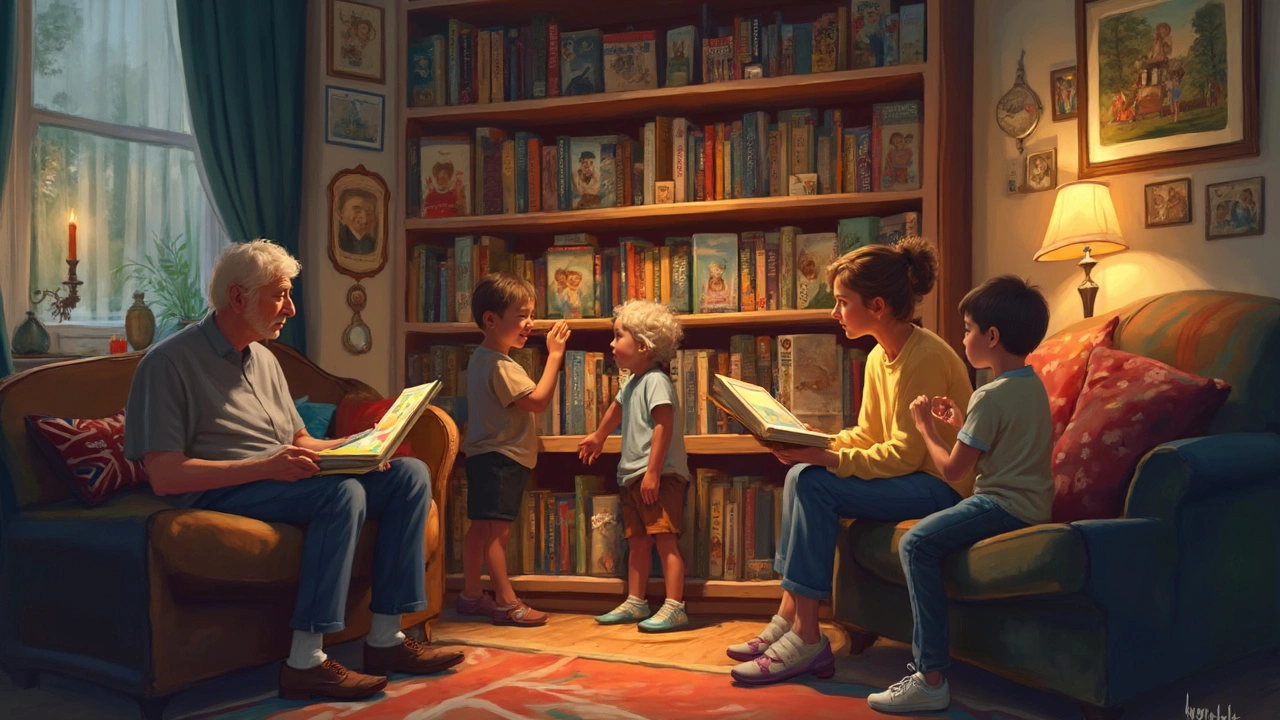
Surprising Perks of a Living Room Bookshelf
You might think a bookshelf is just for holding books, right? Turns out, there’s a lot more to it. For starters, having books out in the open actually makes people read more. A study from the Pew Research Center found that when people keep their books visible, they're way more likely to pick them up—call it the "out of sight, out of mind" rule in reverse. So, if you want to read more (or you want your kids to), leave those book covers facing out.
Another perk: bookshelves spark conversations. Ever noticed how guests drift over and start scanning your shelves? Whether it’s to check out what you’re reading, spot a mutual interest, or make fun of your secret fantasy series stash, bookshelves break the ice. If you’re not big into small talk, let your shelf do the work for you.
Bookshelves are also multitaskers. They can show off your hobbies, photos, art, or record collection without piling things up on tables. Place plants on higher shelves, stash charging cables and remotes in boxes on lower ones, or use a basket for quick storage. Suddenly, all the random stuff that usually clutters up the living room has a legit spot.
And get this—a bookshelf can mess with your brain (in a good way). Research in interior psychology says seeing rows of well-organized shelves at home can make you feel less stressed and more focused. It’s like your brain sees order and starts to chill out.
Finally, shelves boost your room’s vibe. If you pick a shelf that fits your style—think clean wood, splashy colors, or that trendy ladder look—you get instant character. No expensive art needed. Plus, it’s flexible: move things around, rotate decorations, and it'll never get boring.

